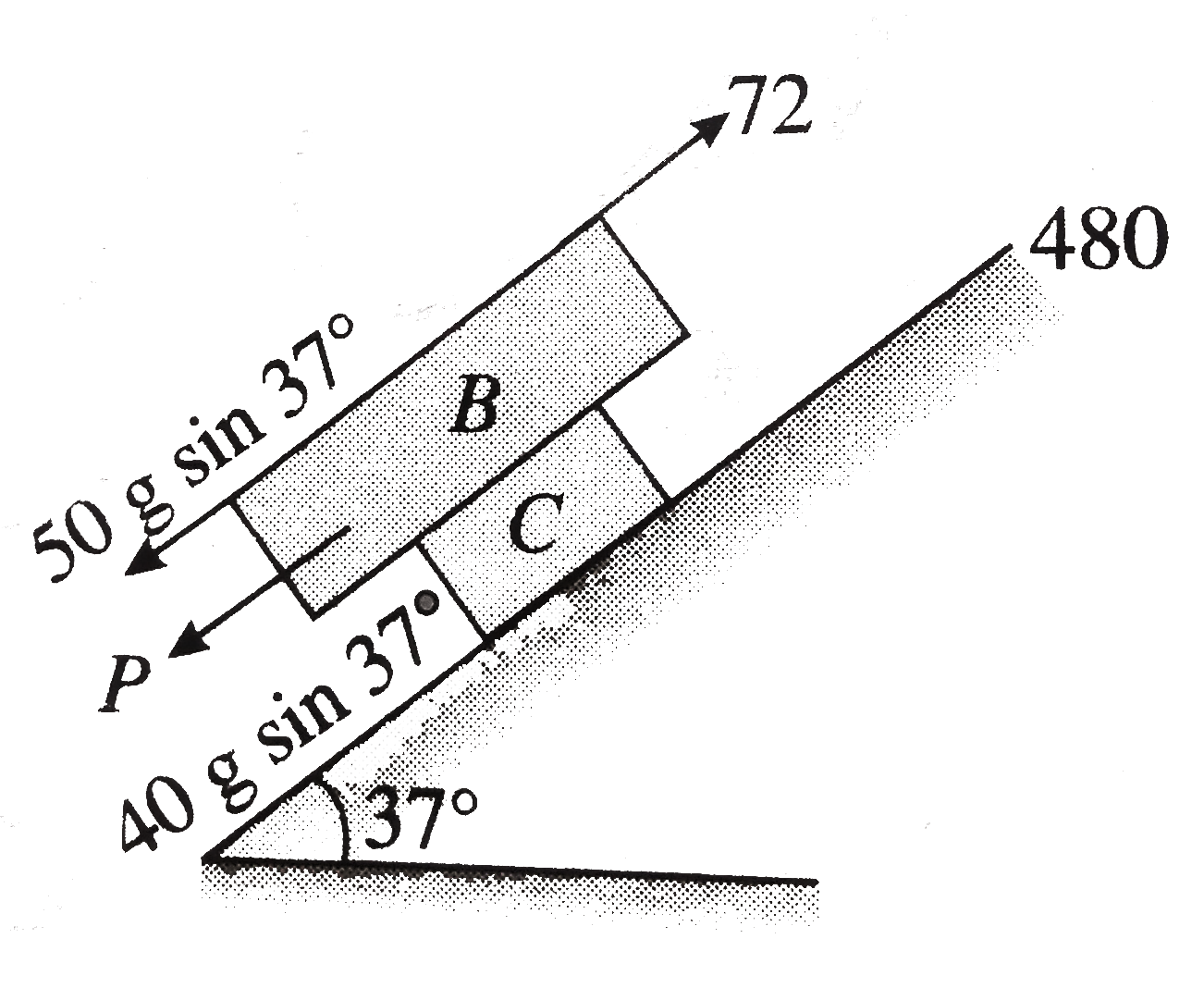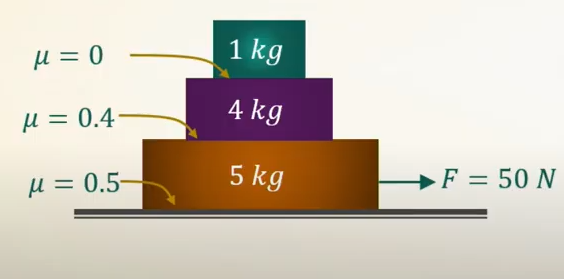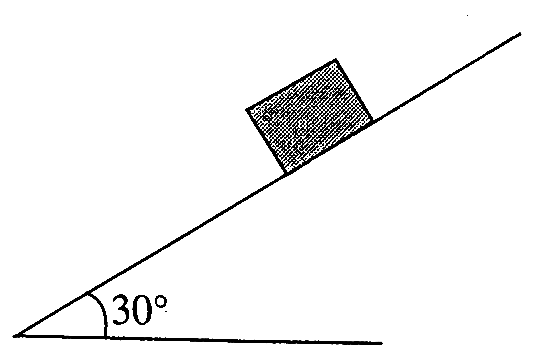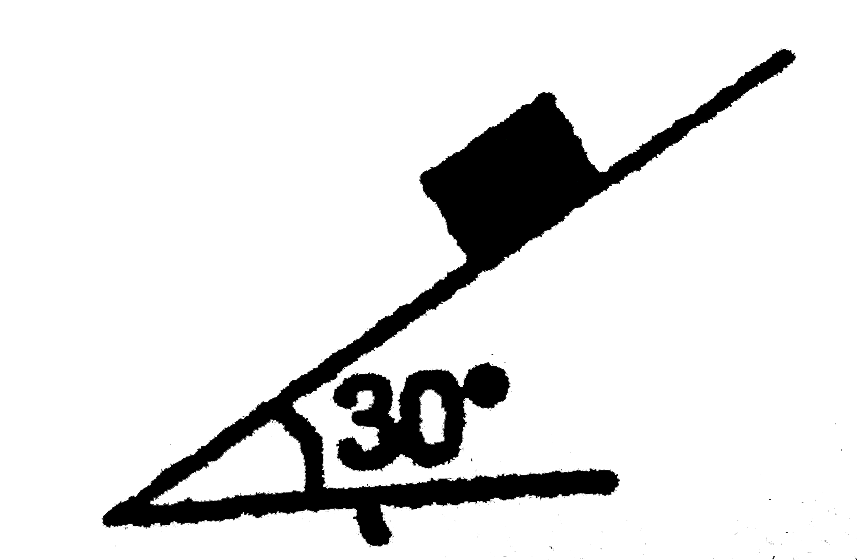
The three flat blacks in the figure are positioned on the 37%∘ incline and a force parallel to the inclined plane is applied to the middle blocks. The upper blocks is prevented from moving by a wire which attaches it to the fixed support. The masses of three blocks in kg and coefficient of static friction for each of the three pairs of contact surfaces is shoen in the figure. Determine the maximum value which force P may have before slipping take place anywhere.



fAB=0.3×30gcos37∘
fABmax=72N
fBCmax=0.4×80gcos37∘=256N
f(Cmax)=0.5×120gcos37∘=480N
when B block is pulled two cases are possible
(1) A & C remains stationary only B tends to move downward.
(2) B & C both moves together and there is just slipping and A & B contact and C and wedge contact Taking case (2) let B & C moves together and there is just slipping between A & B and between wedge and C
⇒P+40gsin37∘+50gsin37&=∘−72−480=0
⇒P=12N
cheking friction between B & C
fBC=40gsin37∘−480=0
fBC=240
which is with in limit socase is correct so max. Force for which there will be no slipping P(max)=12N The at this force both B & C tends to move together.
Topper's Solved these Questions
- CENGAGE PHYSICS DPPBook:CENGAGE PHYSICSChapter:CENGAGE PHYSICS DPPExercise:single correct type
Explore 14 Videos
- CAPACITOR AND CAPACITANCEBook:CENGAGE PHYSICSChapter:CAPACITOR AND CAPACITANCEExercise:Integer
Explore 5 Videos
- CENTRE OF MASS CONVERSATION OF MOMENTUM AND COLLISIONBook:CENGAGE PHYSICSChapter:CENTRE OF MASS CONVERSATION OF MOMENTUM AND COLLISIONExercise:Question Bank
Explore 38 Videos
Similar Questions
The three flat blocks in the figure are positioned on the 30∘ incline and a force parallel to the inclined plane is applied to the middle block . The upper block is prevented from moving by a wire which attaches it to the fixed support . The coefficient of static friction for each of the three pairs of contact surfaces is shwon in the figure . Determine the maximum value which P may have before any slipping takes place .

View SolutionThe coefficient of friction between the block and the inclined plane is μ.
View Solution
Knowledge Check
On a table three blocks (including the first block) are placed as shown in the figure. Mass of each block is m and coefficient of friction for each block is μ. A force F is applied on the block so as to move the system. The minimum value of F should be
 A8μmgB9μmgC7μmgD5μmg
A8μmgB9μmgC7μmgD5μmgA block of mass 2kg is kept on the floor. The coefficient of static friction is 0.4 . If a force F of 2.5N is applied on the block as shown in the figure, the frictional force between the block and the floor will be.
 A2.5NB5NC7.84ND10N
A2.5NB5NC7.84ND10NA horizontal force of 20 N is applied to a block of 10 kg resting on a rough horizontal surface. How much additional force is required to just move the block, if the coefficient of static friction between the block and the surface is 0.4 ?
A15.5 NB10.3 NC8.5 ND19.2 N
Three blocks are placed as shown. The coefficient of friction between any two surfaces is also as given in the diagram. Find the acceleration of the 1kg block at the instant when a force of 50N is applied on 5kg block.

View SolutionA block of mass 5 kg is at rest on a rough inclined surface. If angle of inclination of plane is 60∘, then force applied by it on block is
View SolutionA block of mass 5 kg rests on a inclined plane at an angle of 30∘ with the horizontal. If the block just begins to slide, then what is the coefficient of static friction between the block and the surface?
View Solution
Figure shows a block kept on a rough inclined plane. The maximum external force down the incline for which the block remains at rest is 1 N while the maximum external force up the incline for which the block is at rest is 7 N. The coefficient of static friction μ is:
View SolutionFigure shows a block kept on a rough inclined plane. The maximum external force along the plane downwards for which the block remains at rest is 1N while the maximum external force along the incline upwards for which the block is rest is 7N. The coefficient of static friction μ is

View Solution
